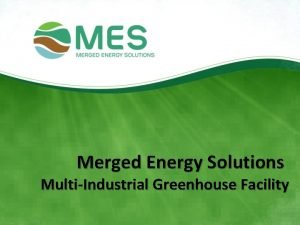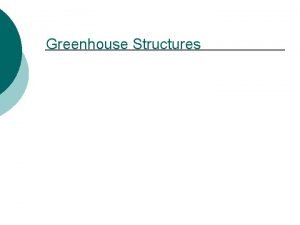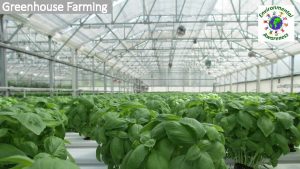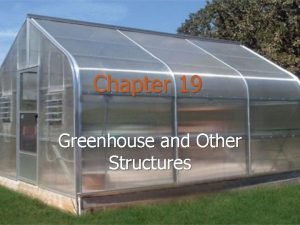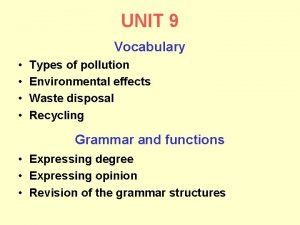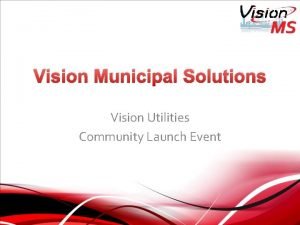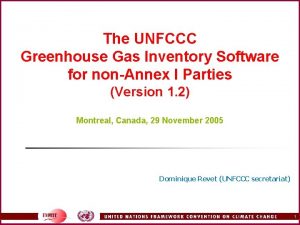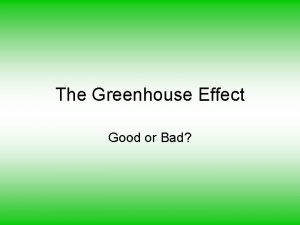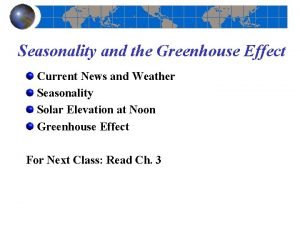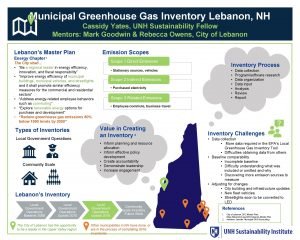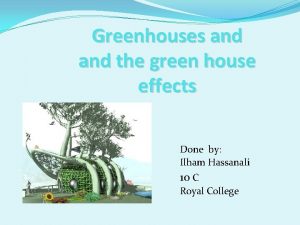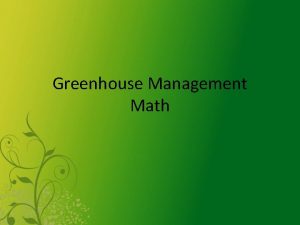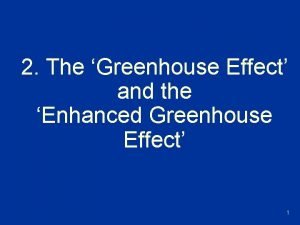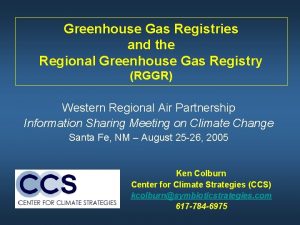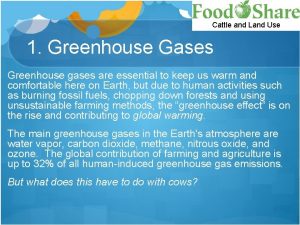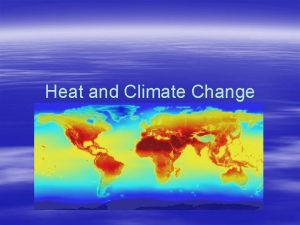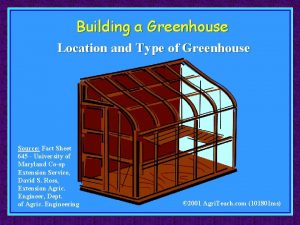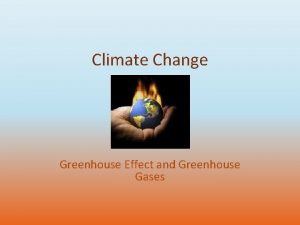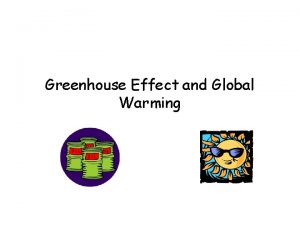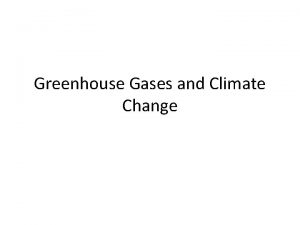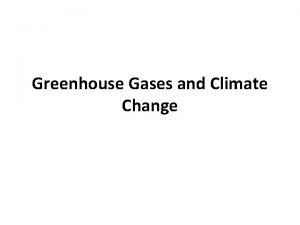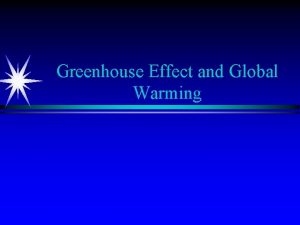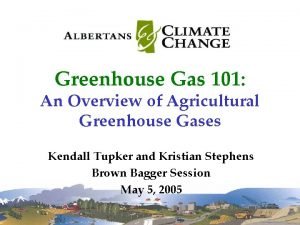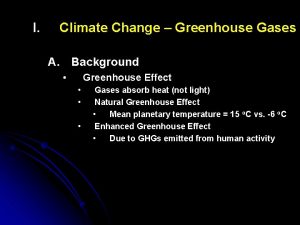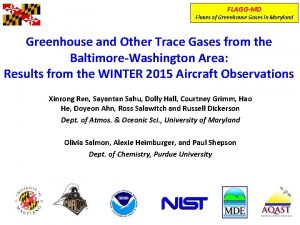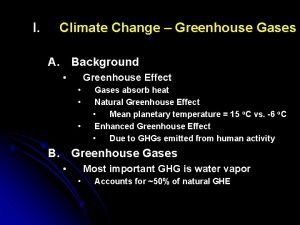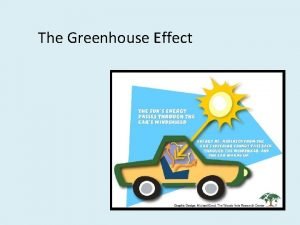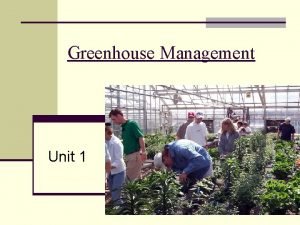Merged Energy Solutions MultiIndustrial Greenhouse Facility Vision and


























- Slides: 26

Merged Energy Solutions Multi-Industrial Greenhouse Facility

Vision and Mission Vision Generating tomorrows growth today Mission Statement Our mission is to renew and build a sustainable Earth by empowering and educating people throughout the world. We collaborate with nature, technology, and people to create sustainable energy and food. We realize our vision by committing cutting-edge technology, building stateof-the-art clean energy and agriculture projects, and investing in the education, health, and well being of people throughout the world.

Multi Industrial Greenhouse (MIG)

Multi Industrial Greenhouse (MIG) Components • Concentrating Solar Thermal • Advanced Biomass Gasification (ABG) • Geo Thermal • High-Density Vertical Farming • Aquaculture • Water Desalination & Purification • Academy of Advanced Technical Science

Concentrating Solar Thermal

Why Concentrating Solar Thermal? The Process A Concentrating Solar Thermal Roof (CSTR) produces electric power by converting the sun's energy into high-temperature heat, which is then channeled through a conventional generator. Efficiency The CSTR is one of the most efficient and dependable producers of solar energy available today. The CSTR is rated at 34 -38% efficiency in terms of translating the direct solar energy to electricity and has a useful life of 50 years. Heating & Cooling The thermal energy can also be used directly for heating and cooling purposes; running it to absorption chillers for cooling and a heat exchanger for heating. Energy Storage Capability Trough designs can incorporate thermal storage—setting aside the heat transfer fluid in its hot phase— allowing for electricity generation several hours into the evening.

Concentrating Solar Thermal How it Works…

Advanced Biomass Gasification (ABG)

Advanced Biomass Gasification (ABG) Generalized Design Concept

Advanced Biomass Gasification (ABG) Products Syngas Ø Electricity Ø Synthetic Diesel Ash Ø Soil Conditioner Purified Water Feedstock Ø Agricultural or Municipal Waste • Low Feedstock Cost • Plant Adaptable to Any Location

Geo-Thermal Hydrothermal Power Systems There are three geothermal power plant technologies being used to convert hydrothermal fluids to electricity - Dry Steam, Flash, and Binary Cycle. The type of conversion used depends on the state of the fluid (whether steam or water) and its temperature. Flash steam plants are the most common type of geothermal power generation plants in operation today. They use water at temperatures greater than 360°F (182°C) that is pumped under high pressure to the generation equipment at the surface. Binary cycle geothermal power generation plants differ from Dry Steam and Flash Steam systems in that the water or steam from the geothermal reservoir never comes in contact with the turbine/generator units. Dry steam power plants systems were the first type of geothermal power generation plants built. They use the steam from the geothermal reservoir as it comes from wells, and route it directly through turbine/generator units to produce electricity.

Power Generation - Summary Between the Concentrating Solar Thermal, Bio-Mass, and Geo. Thermal outputs, a 150 acre MIG facility can generate 20 to 40 megawatts of power. The MIG would consume approximately 3 to 4 megawatts. One (1) megawatt will provide power for approximately 2, 400 average-sized homes. This means an average of 28, 000 to 85, 000 homes can be serviced by one facility, and can be taken off the power grid. This is important when it comes to security because by being independent from the grid, earthquakes, tsunamis and other natural or man-made disasters will not impede the MIG from producing energy, water, fresh produce and fish.

Advanced High-Density Vertical Farming The Advanced High-Density Vertical Farming (AHDVF) or hydroponic growing system does not use soil. The crops are either suspended in water or a water mist is periodically sprayed on the plant root structures of the crops. The water is infused with nutrients like those naturally found in the soil. This system uses no pesticides or fertilizers in this growing environment. Additionally, for example, bees will be introduced into the system to provide a natural pollination cycle. Unlike any genetically modified organisms (GMOs), the seeds are free of any genetic alterations and use only a natural nutrient solution that will allow for organic certification of all the produce.

Advanced High-Density Vertical Farming The current generation of hydroponic greenhouse technology in North America produces fresh tomatoes, bell peppers & cucumbers in sufficient quantities to market all over the country. The MIG System offers immense variety over and above that current level and type of production, including lettuce, herbs and some fruits, such as strawberries. Quadrants of each greenhouse may be organized to maintain a specific growing environment, which will support the crops suited to that environment. The diversification of production will allow for a more balanced and complete produce offering to suit each market served.

Advanced High-Density Vertical Farming The annual production level of the ADHVF described here is projected, at normal operation, to be approximately 90 million pounds - enough produce to feed an average population of 300, 000 people or 60, 000 families.

Water Desalination MES recognizes that, today, water is a precious commodity and with water shortages around the world, it is essential that we are aware of how we can best utilize our resources. With this in mind, we have created a water treatment system known as Alpha Water that will desalinate, reclaim, purify and produce over one and a Half million gallons per day for use by the MIG and for neighboring city use. By incorporating this critical element, we are reducing the amount of water that we use in our facility (or take from other users) and that we are producing the highest quality drinking water possible.

Water Purification Applying the Technology Until now, no one desalting process has proven itself as “the best. ” A variety of factors have come into play in choosing the appropriate process for a particular situation. These factors include the quality of the source water, the desired quantity and quality of the water produced, pre-treatment, energy and chemical requirements, and methods of concentrate disposal. MES, however, has developed the most advanced and unique system, regardless of the water source, by applying additional multiple-step procedures, including the use of quantum mechanics and a plasma bioreactor system. Due to the proprietary nature of this process, it is not detailed in this presentation.

Aquaculture: Opposing Flow Technology The unique and patented “Opposing Flow” technology depicted below also creates a continual current in the culture tank. After the biofilter, the purified water is evenly distributed back into the culture tank, entering from both sides of the tank causing the fish to align themselves in the current, constantly swimming “ upstream” facing either side of the 40’ long tank. With this constant swimming motion, the fish can metabolize the high protein feed into flesh which produces a higher yield, compared to fish grown in circular aquaculture tanks.

Why Produce and Fish? Prior to the early twentieth century, virtually all produce grown was what we now consider organic. No pesticides were used and the only fertilizer available was natural and nutrient rich manure and biodegraded foliage. The soil was also rich from years of continued farming. At that time, the variety of produce varied greatly – for example, there were some 4, 000 varieties of potatoes and approximately 7, 000 varieties of apples in the 1800 s. Today, we are lucky to have maybe four different varieties of potatoes and apples commonly available. After World War I, agriculture started using nitrogen fertilizer in mass quantities - a development derived from the nitrogen explosive used in bombs – to increase crop production. If that wasn’t enough, we developed DDT from poison nerve gas to use as an insecticide. By the mid 20 th century, we moved into the period called the “Green Revolution” which was an attempt to systematize the growing industry and increase food production. However, this led to the dramatic reduction in variety, often to a single crop type, causing further vulnerability to insects and disease. With more insects and disease, the industry was forced to use more pesticides. This ultimately led to the Genetically Engineered seed that would be resistant to the pesticides. All this engineering of nature’s bounty is clearly not a positive development. One prime example of the negative effects of this process is the tomatoes today. These vegetables may be big and red, but they lack the taste and nutrients of naturally-produced tomatoes.

Why Produce and Fish? Continued… The same companies who developed the most common pesticides were also the first companies to patent the first genetically engineered or genetically modified organisms (GMOs), seeds that were immune to the pesticide. Our obesity problem today is not necessarily based primarily on inherited genes and/or our poor eating habits. Rather, the prevalence of GMO products being grown under specific control have lost most of their nutritional value; in order for the human body to obtain its required nutrients, a person must eat more. In turn, by eating more we are taking in excessive calories, which turn to fat and, hence the contribute to the proliferation of obesity. It is time we get back to basics… The Advanced High Density Vertical Farming System that is an integral part of the MIG System, is designed to grow these vegetables the way nature meant them to be grown, with all the nutrients and great taste and without any type of GMO or pesticide use. This is especially important for the health and well-being of the younger generation and for the generations to come.

Why the Combination? Reduced Land Area – Commercial-scale greenhouses produce as much as 30 times the yield of conventional agriculture. That means a 100 -acre greenhouse is equal 3, 000 -acres of horizontal farming production. Reduced Water Consumption - Produce grown in a Multi Industrial Greenhouse (MIG) requires 10% of the amount of water that conventional agriculture consumes. This is primarily due to the technology and management systems employed in the system. The Synergies of Combining Solar, Geo-Thermal and Bio-Mass Energy Systems – ystems Combining these creates particularly high levels of heat, which is required to make steam. This steam drives a turbine that generates electricity. The high-heat generation of the combined system significantly reduces the initial capital costs of the system. Also, while the solar or geo-thermal system is operational during daylight hours, the system requires less bio-mass to fuel the system.

Academy of Advanced Technical Science (TAATS) Academy of Advanced Technical Science

Academy of Advanced Technical Science (TAATS) The Academy of Advanced Technical Science (TAATS) will be a 120, 000 squarefoot institute located on the second floor of the main MIG facility. TAATS will be devoted to teaching students of all walks of life the importance of combining the latest technology with a variety of applications such as agriculture, farming, water treatment, alternative energy, and sustainability, to name just a few. It is our belief that in order for the younger generation to thrive they must become proactive in creating new strategies to enhance mankind’s general advancement. We will provide that training and encourage creative thinking to bring new technologies to life.

MIG Production – 120 acre Annual Production Ø 9 million gallons Synthetic Fuel Ø 40 MW Electricity Ø 90 million pounds Organic Produce Ø 5 million pounds Fish Ø 1. 5 million gallons Potable Water per day

MIG Employment Number of Employees Employment is based on the averages for the type of industry and the size of the Water : 20 facility. These figures Bio-Mass: 25 are also based on the facility operating 24 Solar: 25 hrs a day, 7 days a Greenhouse 300 week and 50 weeks out of the year. This Packing 80 does not take into Sales & Mktg 20 account the branch jobs created up Trucking 20 stream. The Aquaculture 50 anticipated wages for this facility are Total 540 estimated at $12 to $20 per hour, excluding upper management and technical positions. § § § § “Upstream” Industries Supplying MES: Construction Products Solar Mirrors Control Systems Manufacturing Equipment Nutrients Seedlings Hatcheries Merged Energy Solutions Downstream” Industries Supplied By MES: Processing Transportation Wholesaling Retail Food Service Industries Supplying “Upstream” Industries: Piping Electronic Parts Raw Material Suppliers Agriculture Accessories Industries Supported by Household Spending of Income Earned in Other Industries Associated with MES: Food Housing Transportation Clothing Entertainment Education Industries Supplying Downstream” industries Examples: Packaging Truck Manufacturing Utilities

Contact Us R. Michael Smith – CEO Los Angeles, California Phone: +1 -714 -262 -6839 email: michael@mergedenergy. com
 Taats technical services llc
Taats technical services llc Suggested upper merged ontology
Suggested upper merged ontology Secondary line of the ikebana representing mankind
Secondary line of the ikebana representing mankind Ffa student handbook
Ffa student handbook Northern renaissance thinkers merged humanist ideas with
Northern renaissance thinkers merged humanist ideas with Energy energy transfer and general energy analysis
Energy energy transfer and general energy analysis Energy energy transfer and general energy analysis
Energy energy transfer and general energy analysis Structured light
Structured light Energy systems integration facility
Energy systems integration facility Thank you
Thank you Lath house greenhouse pros and cons
Lath house greenhouse pros and cons Structural components of greenhouse
Structural components of greenhouse Advantages of greenhouse farming
Advantages of greenhouse farming Types of greenhouse structures
Types of greenhouse structures Difference between natural and artificial greenhouse
Difference between natural and artificial greenhouse A greenhouse is a building whose sides and roof
A greenhouse is a building whose sides and roof Ridge and furrow greenhouse
Ridge and furrow greenhouse Vision municipal solutions
Vision municipal solutions Greenhouse inventory management software
Greenhouse inventory management software Is the greenhouse effect good or bad
Is the greenhouse effect good or bad Why is the greenhouse effect important
Why is the greenhouse effect important Deborah greenhouse md
Deborah greenhouse md Yates city greenhouse
Yates city greenhouse Greenhouse effect in simple terms
Greenhouse effect in simple terms Uneven – span greenhouse
Uneven – span greenhouse Greenhouse ventilation calculator
Greenhouse ventilation calculator Greenhouse effect
Greenhouse effect
